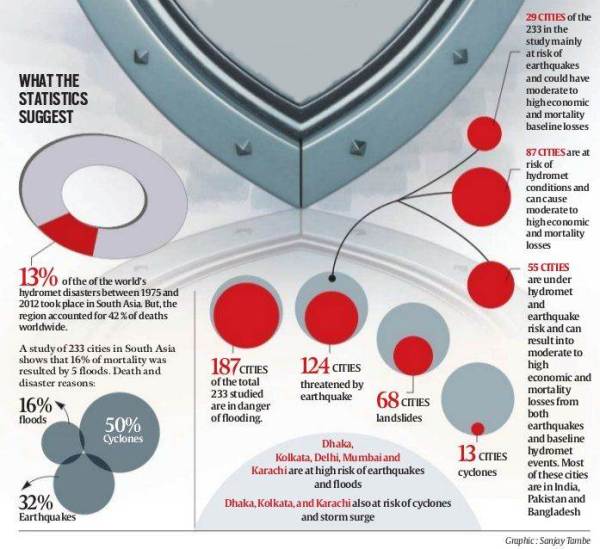Skip to content
- According to the Government of India, at least 38 cities lie in
high-risk seismic zones and
- almost 60 % of the landmass of the
subcontinent is immensely vulnerable to earthquakes or other natural
disasters.
- The fact that a large section of the population is poor and lives in
houses and cities that are hastily built and are not earthquake
resistance raises the risk of human impact, in case of any disaster.
Also, the lack of government’s preparedness to deal with such situations
may add to the woes.

- A report prepared by the World Bank on urbanisation in South Asia
states that while the risks are high and growing on account of rising
population density in urban areas, government’s need to plan more
resilient cities and policy makers need to plan holistically to deal
with any situation. The report enlists four recommendations that policy
makers of a country need to take into account.
- * Identify risk by using urban risk assessment framework
-
* Mitigate risk by planning critical and multipurpose safe and resilient infrastructure
-
* Develop a risk financing scheme to provide immediate liquidity in the aftermath of disasters and to build financial resilience
-
* Build strong institutions and collect, share, and distribute disaster data.
- Rising urbanisation and growing risk
- Concentration of population in urban areas has increased the risk
exposure in South Asia to natural hazards in risk-prone areas such as
deltas, floodplains, coasts, and the Himalayan belt.
- The report points
that in South Asia, the number of people exposed to natural hazards is
growing by 3.5 per cent a year.
- Solutions:
- The first step in developing a resilience strategy is to identify
risks at national and city level. It is also important to identify the
vulnerabilities of communities and potential exposure to disasters.
Urban risk assessments aim to identify critical infrastructure and
develop early warning systems.
- Mitigating risks call for developing both structural and
nonstructural measures. While structural measures include dams, wave
barriers and retrofitting of buildings etc, the nonstructural measures
comprise policies and laws, practices, and agreements such as building
codes, land-use planning, public awareness and information.
- An advance financing plan should include reserves, calamity funds,
budget contingencies, a contingent debt facility and risk transfer
mechanisms. While having insurance, reinsurance and parametric insurance
is important, alternative risk transfer instruments include catastrophe
bonds.
- A detailed risk assessment is necessary for designing a national
catastrophe risk strategy. While several South Asian countries have
developed financing programs for disasters, the most extensive risk
financing is in Sri Lanka. It is the first country to develop a
“catastrophe draw down option” with assistance from the World Bank
through a development policy loan. “The loan provides a line of credit
that can be drawn on partially or in full if the country d clares a
state of emergency after a natural disaster.”


0 comments:
Post a Comment